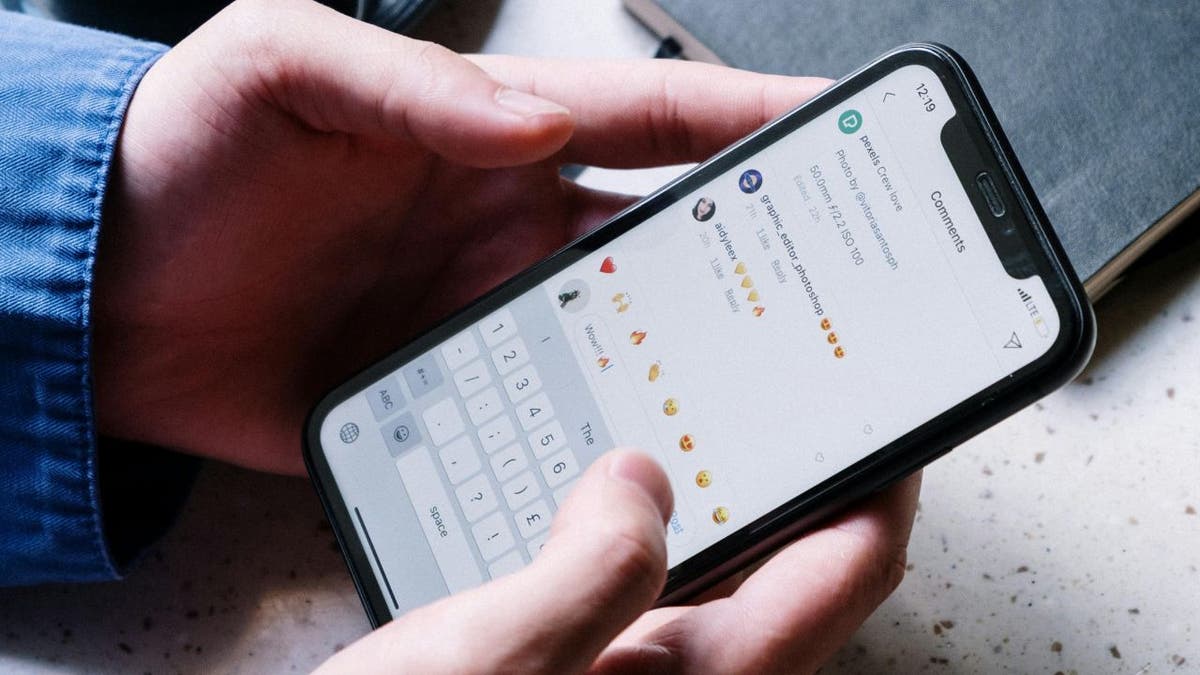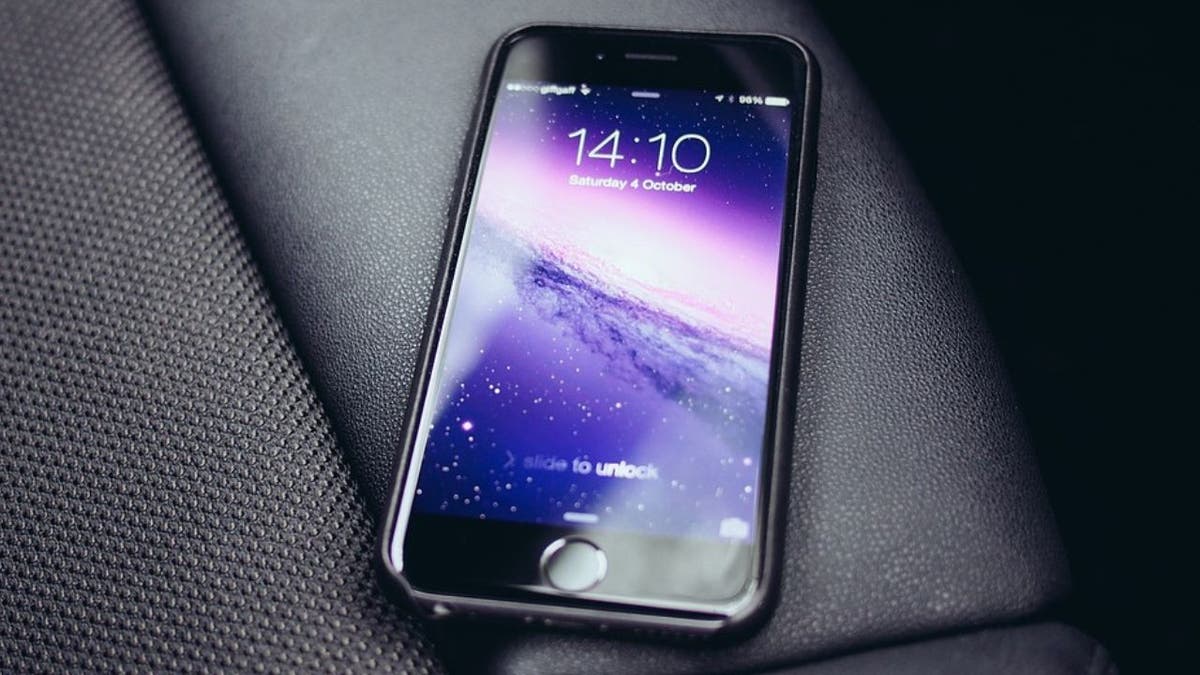Europe has an electric bike problem. Direct-to-consumer e-bikes from inexpensive Chinese brands like Engwe and countless others can be easily purchased online despite openly flouting EU restrictions. They feature throttles and powerful motors that can be easily unlocked to far exceed the 25km/h (16mph) legal speed limit — no pedaling required.
Technology
Is your smartphone spying on you without you even knowing it?

Researchers at MIT’s Computer Science and Artificial Intelligence Laboratory (CSAIL) recently revealed a startling new privacy threat.
Our smartphones’ ambient light sensors might be turned into makeshift cameras.
A woman on her iPhone (Kurt “CyberGuy” Knutsson)
From brightness adjustment to privacy invasion
Ambient light sensors are commonplace in smartphones, primarily used to adjust screen brightness according to environmental lighting. However, CSAIL researchers have demonstrated that these sensors could potentially be repurposed to capture images of a user’s surroundings.
By employing a computational imaging algorithm, they managed to recover environmental images from the perspective of the phone’s screen, utilizing only the light intensity data from these sensors.
CLICK TO GET KURT’S FREE CYBERGUY NEWSLETTER WITH SECURITY ALERTS, QUICK VIDEO TIPS, TECH REVIEWS AND EASY HOW-TO’S TO MAKE YOU SMARTER

Two people looking at their iPhones (Kurt “CyberGuy” Knutsson)
A comprehensive privacy threat
The implications of this discovery are far-reaching.
“Ambient light sensors are tiny devices deployed in almost all portable devices and screens that surround us in our daily lives,” notes Princeton University professor Felix Heide. The study underscores a privacy threat that spans a broad spectrum of devices, previously underestimated in its potential impact.
WHAT IS ARTIFICIAL INTELLIGENCE (AI)?

A person on a cell phone (Kurt “CyberGuy” Knutsson)
Gesture interception and interaction capture
Beyond static images, the study suggests that ambient light sensors could intercept user gestures, like swiping and sliding, capturing interactions with phones during activities such as video watching. This capability challenges the belief that ambient light sensors are harmless in terms of private data exposure.

An iPhone (Kurt “CyberGuy” Knutsson)
MORE: BEST WAY TO PROTECT YOUR DEVICES FROM GETTING HACKED
The call for tighter permissions
Yang Liu, a Ph.D. candidate at MIT EECS and CSAIL, warns that ambient light sensors, in conjunction with display screens, can capture our actions without consent, posing significant privacy risks. The researchers urge operating system developers to tighten permissions for these sensors, reducing their precision and sampling rate.

Person on an iPhone (Kurt “CyberGuy” Knutsson)
Looking ahead: Designing for privacy
To mitigate these security concerns, the study proposes granting users control over ambient light sensor permissions akin to camera permissions. Additionally, future device designs might include ambient light sensors positioned away from the user, such as on the side of the device, to prevent unauthorized visual data capture.
While the study’s findings prompt a reevaluation of sensor permissions and design, it’s equally important to recognize the broader context of smartphone security vulnerabilities. Let’s delve into the realm of spyware, another pressing concern where even the most vigilant users can find themselves compromised.

A woman talking on her cell phone (Kurt “CyberGuy” Knutsson)
Understanding spyware vulnerability on your smartphone
You might not realize it, but your phone could be more exposed to spyware than you think. Just a small slip-up while you’re browsing the web, and you could accidentally invite a cyber-spy into your life. If you’re an Android user, be extra cautious. Your phone is usually more at risk than iPhones.
But here’s the kicker. Even if you’re super careful, you’re not totally out of the woods. If you don’t update your phone’s software regularly or if you’ve jailbroken it, you’re playing with fire. Here are some telltale signs of spyware on your phone.

A woman on her smartphone (Kurt “CyberGuy” Knutsson))
MORE: SNEAKY SPYWARE IS AFTER YOUR MOST SENSITIVE DATA
The telltale sign of spyware on your phone
Is your phone acting strange? Here are the telltale signs of spyware on your device.
Unusual noises: Beeping, faint voices or static during calls might not just be network issues. They could signal an eavesdropping attempt.
Performance lags: If your phone suddenly slows down or the battery drains rapidly, spyware might be hogging your resources.
Sensors activate unexpectedly: Modern smartphones signal when cameras and mics are in use. If this happens sans your input, investigate promptly.
Mysterious apps and files: New, unrecognizable apps or files might indicate that your phone’s security has been breached.
Excessive pop-ups and spam: An uptick in ads, error messages or scam texts may be adware, a common companion to spyware.
Overheating issues: Like performance lags, overheating can suggest that spyware is overworking your phone’s internals.

Smartphone on the seat of a vehicle (Kurt “CyberGuy” Knutsson)
MORE: MALICIOUS ANDROID SPYWARE DETECTED IN OVER 100 POPULAR APPS
Several steps you can take to protect yourself from spyware on your smartphone
1. Have good antivirus software: Yes, antivirus protection can help detect and disable spyware on your smartphone. The best way to protect yourself from clicking malicious links that install malware that may get access to your private information is to have antivirus protection installed on all your devices. This can also alert you of any phishing emails or ransomware scams. Get my picks for the best 2024 antivirus protection winners for your Windows, Mac, Android & iOS devices.
2. Remove unfamiliar apps and files: If you suspect your phone has been hacked, promptly remove any unfamiliar apps.
3. Restart your device: Rebooting your phone can sometimes stop spyware from running.
4. Update to the latest software: As mentioned before, updates can patch vulnerabilities.
5. Be cautious when browsing: Avoid clicking on suspicious links or downloading files from untrusted sources.
6. Update your phone regularly: Updates often include security patches that can help protect your device from spyware and other vulnerabilities.
7. Don’t jailbreak your phone: Jailbreaking removes security restrictions that can make your phone more susceptible to spyware.
8. Look for unusual activity: This includes unusual noises during calls, performance lags, unexpected sensor activation, mysterious apps or files, excessive pop-ups and overheating.
9. Delete unwanted or unused apps: Some apps use your device’s camera and microphone and collect your data even while it is not in use. Getting rid of unused apps frees up storage space on your phone and declutters your lock screen. It can also eliminate one more potential app that might be collecting information from you unknowingly.
On an iPhone:
- Hard press the app icon of the app you want to delete
- Select Remove App
- You’ll be prompted to confirm your decision in the next window by tapping Delete App
- Then again by tapping Delete
On an Android:
- Go to the Google Play Store app
- At the top right, tap the Profile icon
- Select Manage apps & devices, click Manage
- Select name of the app you want to delete
- Select Uninstall
Android settings may vary based on the manufacturer’s settings.
While it may seem like an extra effort to review and change your apps’ permission settings, it’ll give you more peace of mind knowing which apps have access to specific device functions and data. Most devices now have a dedicated part of their settings to view which apps are using the different functions of your phone and what data it has access to.
10. Changing camera settings: It may seem simple to just give access to your camera to certain apps. This way, you can easily use the camera function whenever you pull up the app to use. There are, however, apps that do not need access to your camera to function. Does your navigation app need access to your camera even when it is not in use? Take back control of your camera by using the steps below to find out which apps have access to your camera and turn it on or off.
On an iPhone:
- Go to Settings
- Scroll down and select Privacy or Privacy & Security
- Select Camera
- You can see which apps have access to your camera. Of course, you can leave the apps where it makes sense to have access to your camera toggle on. For apps that do not, you can toggle access off (it will be grayed out)
On an Android:
Android settings may vary based on the manufacturer’s settings.
- Open Settings
- Select Apps
- Select the app you want to change (If you can’t find it, select ‘See all apps’)
- Select Permissions to view if you allowed or denied any permissions for the app
- To change a permission setting, select it, then choose Allow only while using the app, Ask everytime or Don’t allow
11. Restrict camera and microphone permissions: Restricting camera and microphone permissions can make it more difficult for spyware to access these features.
On an iPhone:
- Go to Settings
- Scroll down and select Privacy or Privacy & Security
- Select Microphone
- You can see which apps have access to your microphone. Of course, you can leave the apps where it makes sense to have access to your microphone toggle on. For apps that do not, you can toggle access off (it will be grayed out)
On an Android:
Android settings may vary based on the manufacturer’s settings.
- Open Settings
- Select Apps
- Select the app you want to change (If you can’t find it, select ‘See all apps’)
- Select Permissions to view if you allowed or denied any permissions for the app
- To change a permission setting, select it, then choose Allow only while using the app, Ask everytime or Don’t allow
MORE: NEWLY IPHONE SPYWARE TOOL SOLD TO GOVERNMENTS FOR TARGETED SURVEILLANCE
Kurt’s key takeaways
In a world where our smartphones are virtual extensions of ourselves, the discoveries at MIT’s CSAIL cast a new light on what we often take for granted. As we navigate the delicate balance between convenience and privacy, it’s clear that the devices we depend on daily harbor capabilities far beyond their intended use, prompting a necessary conversation on security, awareness and the evolving landscape of digital privacy.
With the revelation that devices we use daily, like smartphones, can be exploited in ways that compromise our privacy — such as converting ambient light sensors into makeshift cameras — what steps do you believe technology companies and governments should take to protect personal privacy? Let us know by writing us at Cyberguy.com/Contact
For more of my tech tips and security alerts, subscribe to my free CyberGuy Report Newsletter by heading to Cyberguy.com/Newsletter
Ask Kurt a question or let us know what stories you’d like us to cover
Answers to the most asked CyberGuy questions:
Copyright 2024 CyberGuy.com. All rights reserved.

Technology
Engwe Mapfour N1 Pro e-bike review: the new ‘premium’

Here in Amsterdam, cheap Super73-knockoffs ridden at almost twice the legal speed have made the city’s renowned bicycle lanes increasingly chaotic and dangerous. Across the Netherlands, over 10,000 of these electric “fat bikes” were seized in 2024.
Engwe’s new Mapfour lineup is the company’s attempt at going legit by expanding from souped-up electric fat bikes and foldables into “premium commuter” e-bikes. And because they’re the first e-bikes that Engwe has designed exclusively for European roads, the company swears they can’t be unlocked for more speed.
I’ve been riding the new Mapfour N1 Pro model for the last few weeks. It lists for €1,899 (almost $2,000), or €1,799 during the initial launch — a price that brings heightened expectations.
The N1 Pro is slathered in premium capabilities like GPS/GSM tracking for which some bike makers charge subscriptions. The monocoque frame and fork are made from carbon fiber supplied by Toray — “the same high-quality carbon fiber as Trek and Specialized,” claims Engwe. There’s even turn-by-turn navigation built into the full-featured app, a large colorful display integrated into the handlebars, and a built-in mechanical lock in the rear wheel hub that automatically engages when the bike is turned off and stationary.
My review bike was missing a fender bolt, occasionally flashed a strange error code, and the solar-powered rear light won’t turn on. Still, it’s likely the highest quality electric bike Engwe has ever made.

$1714
The Good
- Looks and rides sporty
- Long list of features for price
- Removable battery
- Can’t be speed hacked
The Bad
- Strange error messages
- Servicing parts likely an issue
- Doesn’t support height range claimed
- Can’t be speed hacked
I have lots of experience with assembling direct-to-consumer e-bikes and the N1 Pro was ready to ride in about an hour, which is typical. Even with a carbon-fiber frame it weighs 20.1kg (44lbs) fully assembled according to my scale, which is heavy for an e-bike — just not Veloretti-heavy.

In the box you’ll find a basic toolset that includes everything needed for assembly and instructions written in stellar English unlike some previous Engwe tutorials I’ve read. I had to assemble the pedals, front wheel, kickstand, handlebar, and fenders, and fish out a replacement fender bolt from some spare bicycle parts I had lying around. I then went to adjust the saddle to my height only to discover that I was too tall for the N1 Pro.
The saddle stem has a marked safety line that stops well before the height needed for my 6 foot (183cm) frame, despite being sold in the Netherlands where I’m considered a short king. Nevertheless, exceeding the line by about 2.5cm (one inch) hasn’t made the saddle feel insecure, even when riding over rough cobblestones. Engwe claims the N1 Pro supports riders from 165–190cm, and is considering offering the option for a longer saddle stem at checkout based upon my feedback.
The N1 Pro’s geometry puts the rider into what’s essentially a mountain bike stance: a moderate forward lean with hands spread wide out in front of the body. That wrist and body angle combined with a rather stiff saddle are not ideal for riding long distances, especially in combination with a backpack that’ll put even more weight on the hands and derrière. I do like that fun, sporty posture over short distances, but if you’re looking for a more relaxed ride then Engwe has the upright €1,399 MapFour N1 Air available in both step-over and step-through frames.




The 250W mid-drive Ananda motor on the N1 Pro is nearly silent under the din of road noise, and the integrated torque sensor provides an intuitive pedal-assist at all speeds. It produces up to 80Nm of torque that lets me easily start from a dead stop in fourth gear (of seven) on flat roads, but testing on a hill with a gradient of about 15 percent required a start from first gear. Typically, I only needed to shift to a high gear when I wanted to use my leg power to propel the bike at speeds above the 25km/h motor cutoff.
Despite claiming a range of up to 100km from its modest 360Wh battery, my first test performed over a few weeks yielded just 23km off a full charge in near-freezing conditions. I usually rode in power setting three of five on mostly flat roads. The second test performed on a single warmer day improved the range to 27km with 28 percent charge remaining — or an estimated 36km if I had time to run the battery dry for a below average 10Wh consumed per kilometer travelled. The bike battery seems to suffer from idle battery drain of about 1-2 percent per day when parked inside my house.
Worrisome for a “premium” e-bike: on two occasions I saw an “09” error message flash on the display which Engwe is still diagnosing. Once, while starting the bike after it had been sitting outside in the rain for a few hours. Another time after riding home on a rain-soaked street while switching between the N1 Pro’s regular and high-beam lights. In the first case, a simple reboot cleared it and I was able to ride away fine, but the other time required riding home under my own power before it inexplicably cleared the next morning.
- The bike’s integrated display is readable in all lighting, and shows the remaining battery level, speed, power level, and even distance and direction of next turn if using the navigation built into the useful but overwrought Engwe app.
- I didn’t find Engwe’s turn-by-turn navigation very useful as the guidance presented on the display wasn’t informative or urgent enough for me to make confident decisions when traversing the dense network of crossroads in Amsterdam.
- It has a very loud alarm that can ward off thieves and help locate the e-bike in large parking garages.
- The daytime running lights are fun and help with visibility, but also dorky if you choose the animated options.
- The solar-powered rear light never worked on my review unit.
- Engwe provides a chain guard on shipping units.
- The hydraulic disc brakes from an unspecified vendor provide good controlled stops.
- Includes a 1-year warranty on electrical components, chassis, and battery.
1/19
There was a time when premium e-bikes had list prices around €2,000 / $2,000. Those days are as gone as the free venture capital propping up e-bike startups, pushing premium prices up to a starting price closer to €3,000 / $3,000. The Engwe N1 Pro is therefore priced about right. It’s not a bad e-bike, but it’s also not great despite checking off lots of features on a marketing sheet.
Just remember, servicing a direct-to-consumer e-bike can be a problem as it requires the ready availability of spare parts and the knowledge to replace them. As with any electric bike exposed to the elements and regular road use, the N1 Pro’s motor and any proprietary electronics like the controller, display, battery, lights, buttons, and integrated lock will eventually need servicing. So you’d better be on very good terms with your local bike shop or be handy with a wrench and oscilloscope to prevent your mail-order e-bike from quickly turning into e-waste.
Photography by Thomas Ricker / The Verge
Technology
Elon Musk’s SpaceX prepares for 8th Starship launch, pending FAA approval

Elon Musk’s SpaceX is preparing to launch the eighth flight test of Starship from Boca Chica, Texas, which could blast off as soon as this Friday as long as the Federal Aviation Administration (FAA) gives its approval.
“Starship Flight 8 flies Friday,” Musk, the CEO of SpaceX, said in a post on X Sunday.
For the first time, the upcoming flight has a planned payload deployment and multiple experiments on re-entry geared toward returning the upper stage booster to the launch site to be caught.
The launch will also include the return and catch of the Super Heavy booster that will blast the rocket off the launchpad.
STARSHIP UPPER STAGE LOST ON SEVENTH TEST FLIGHT, DEBRIS SEEN SPEWING IN SKY
Starship Flight 7 launches from Starbase, Texas, before its upper stage was lost. (Associated Press)
During the flight test, Starship will deploy four Starlink simulators, which are about the same size as next-generation Starlink satellites, SpaceX said.
The Starlink simulators will be deployed in the same sub orbit as Starship and are expected to burn up upon re-entry.
While Starship is in space, SpaceX also plans to relight a single Raptor engine.
POWERFUL WEBB TELESCOPE SPIES SPECTACULAR STAR BIRTH CLUSTER BEYOND THE MILKY WAY

Starship Flight 7 launches from Starbase, Texas. (Associated Press)
If all goes as planned, the launch window will open at 6:30 p.m. ET.
The launch comes more than a month after SpaceX launched Starship Flight 7 from the Starbase test site in Boca Chica, which resulted in Starship experiencing a “rapid unscheduled disassembly” nearly 12 minutes into the flight.
The Super Heavy booster descended back to Earth, where it maneuvered to the launch and catch tower arms at Starbase, resulting in the second ever successful catch of Super Heavy.
Starship, however, was not as successful.
MERGER OF MASSIVE BLACK HOLES FROM EARLY UNIVERSE UNCOVERED BY WEBB TELESCOPE, SCIENTISTS SAY
“Starship experienced a rapid unscheduled disassembly during its ascent burn,” SpaceX said in a statement Jan. 16. “Teams will continue to review data from today’s flight test to better understand root cause. With a test like this, success comes from what we learn, and today’s flight will help us improve Starship’s reliability.”
SpaceX has investigated what caused Starship to break apart, though the investigation remains open.
For Starship Flight 8 to blast off, the FAA must give its approval, which could come in a few ways.
In 2023, the FAA issued a five-year license to SpaceX for launches from Texas, which is revisited for every launch in case modifications need to be made for things like the trajectory of the rocket. The FAA could grant approval once mission specifics and license modifications are made, the FAA told Fox News Digital.
But also lingering is the open investigation into the Starship Flight 7 mishap. To fly again, the investigation needs to be closed, and the FAA must accept the findings. Specifically, the FAA weighs whether the incident put public safety at risk.
At the time of this writing, the investigation had not been closed, and the FAA had not given approval. Still, it is common for the approval to be issued a day or two before launch, the FAA noted.
SpaceX did not respond to Fox News Digital’s request for comment on the matter.
Fox News Digital’s Louis Casiano contributed to this report.
Technology
Longer-lasting laptops: the modular hardware you can upgrade and repair yourself

The goal, Patel says, is to continuously cycle through all of Framework’s actively supported laptops, updating each of them one at a time before looping back around and starting the process over again. Functionality-breaking problems and security fixes will take precedence, while additional features and user requests will be lower-priority.
-

 Technology1 week ago
Technology1 week agoVision Pro apps: the good, the bad, and the ridiculous
-

 News1 week ago
News1 week agoDominican officials cram thousands of inmates facing no charges into overcrowded prisons
-

 Politics1 week ago
Politics1 week agoTop federal agency exposed for spending billions on migrants in a single year
-

 Culture1 week ago
Culture1 week agoAre NFL players as college coaches here to stay? Why DeSean Jackson, Michael Vick can work
-

 News1 week ago
News1 week agoKamala Harris Has Scrambled the California Governor’s Race Without Entering It
-

 Culture1 week ago
Culture1 week agoBook Review: ‘Theory & Practice,’ by Michelle de Kretser
-

 Technology1 week ago
Technology1 week agoReddit vs. Wall Street: the latest in the GameStop saga
-

 Lifestyle1 week ago
Lifestyle1 week ago‘Modern Love’ Podcast: Why Gossiping Could Help Your Love Life

















